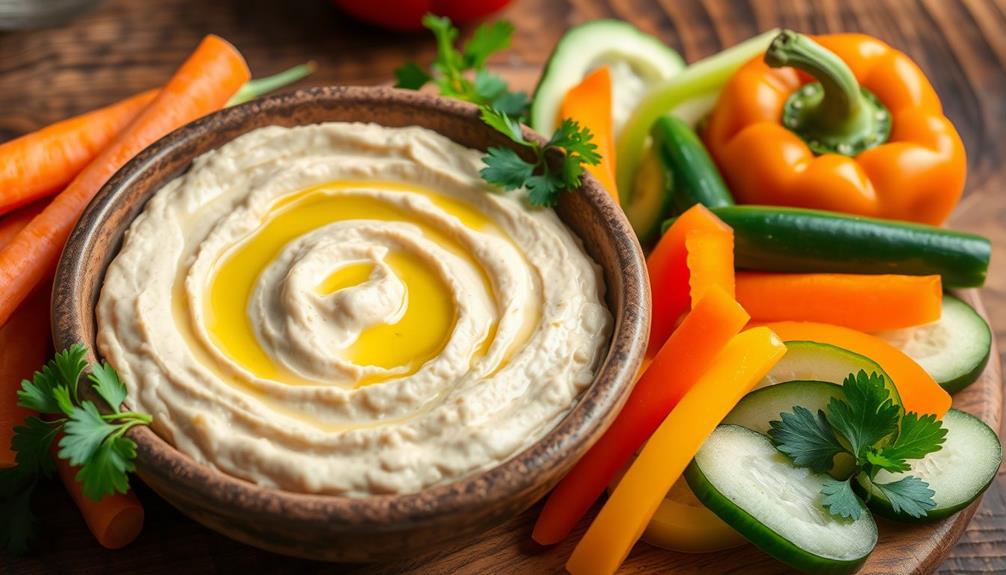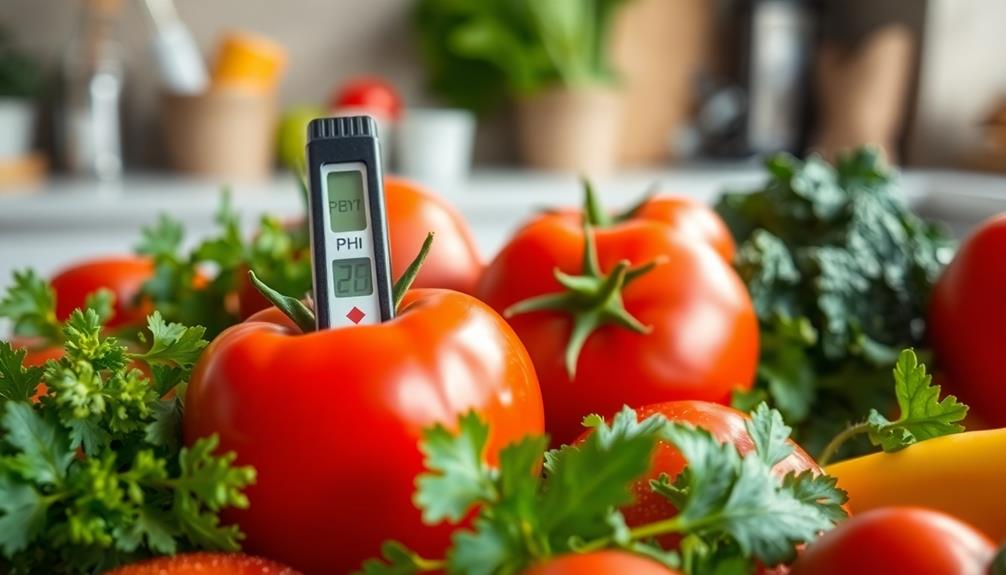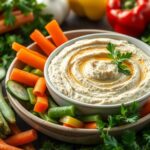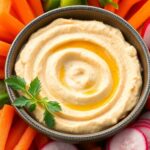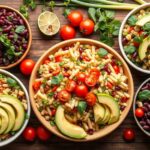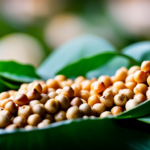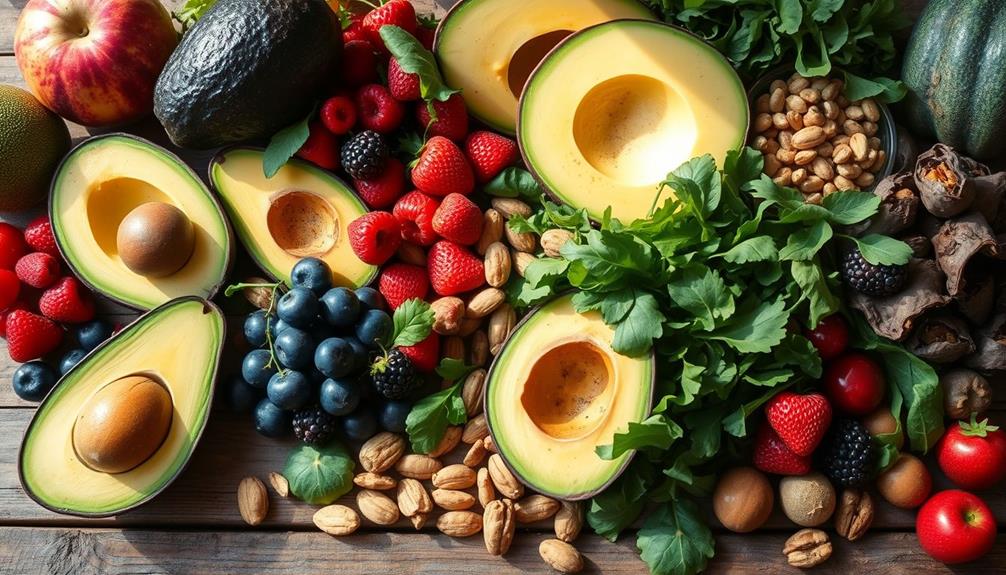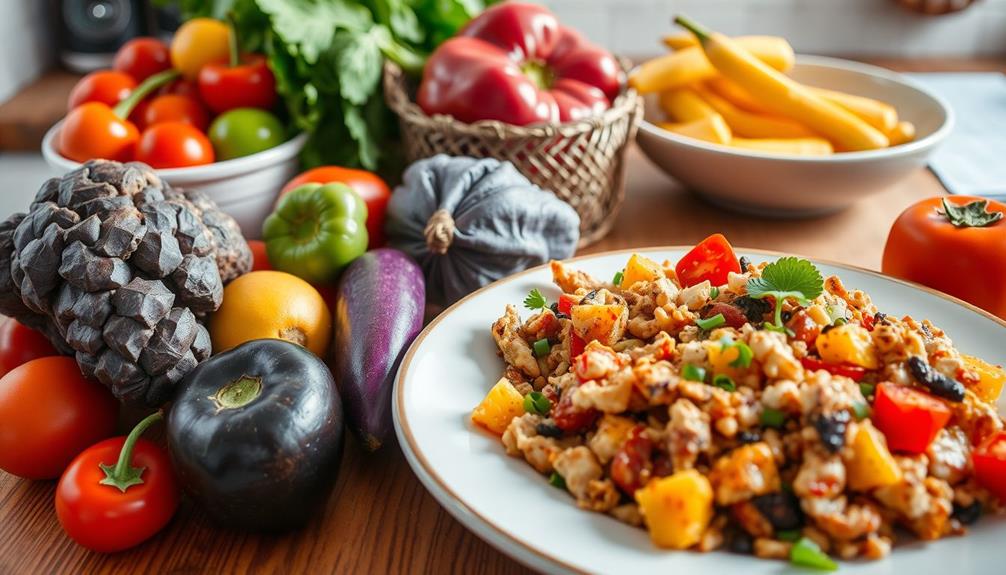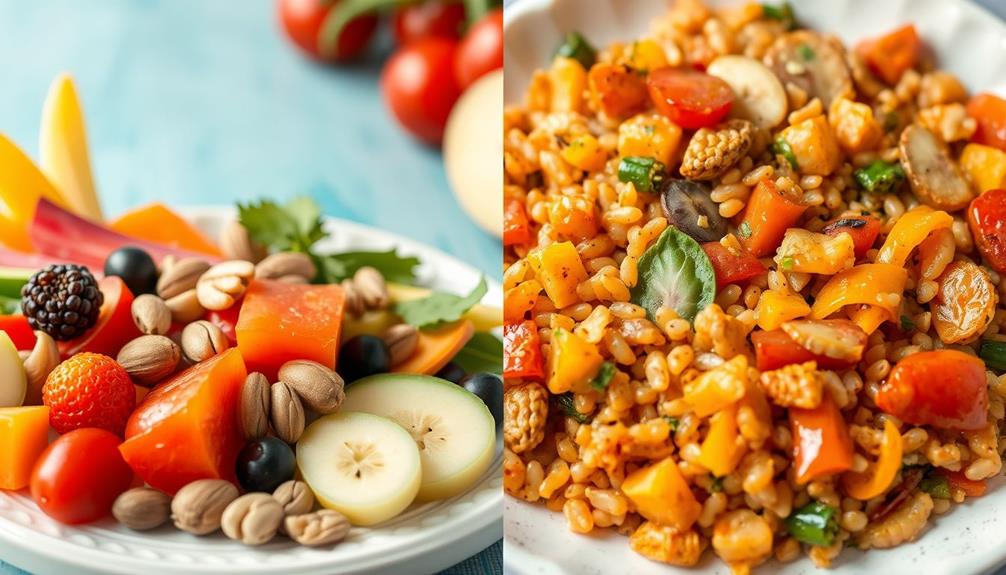Hummus isn't typically considered raw food because traditional recipes use cooked chickpeas and other heated ingredients. However, you can make a raw version by using sprouted chickpeas and unprocessed components like raw tahini, fresh lemon juice, and garlic. This raw alternative retains more nutrients and enzymes beneficial for digestion. If you're keen on enjoying a raw hummus, you'll want to soak and sprout the chickpeas before blending them with your other ingredients. There are tasty recipes and tips available that can help you whip up a delicious raw hummus at home.
Key Takeaways
- Traditional hummus is made with cooked garbanzo beans, disqualifying it as raw food.
- Raw hummus can be made using sprouted beans and unheated ingredients.
- Commercial hummus often undergoes heat pasteurization, confirming it's not raw.
- Always check labels for non-vegan additives in flavored hummus varieties.
- Raw hummus retains nutrients and live enzymes, enhancing health benefits compared to traditional versions.
Understanding Veganism
In recent years, veganism has gained significant traction as more people seek to align their lifestyles with ethical and health-conscious choices. This lifestyle excludes all animal products, including meat, eggs, dairy, and honey, focusing instead on cruelty-free choices that promote the ethical treatment of animals. By adopting veganism, you actively minimize animal exploitation, making a statement about your values.
Additionally, many plant-based foods, like celery juice, provide high levels of antioxidants and vitamins, further enhancing the health benefits associated with a vegan diet.
The movement's popularity is driven by growing concerns about health, environmental sustainability, and animal rights. A well-planned vegan diet can provide all essential nutrients, and research suggests it's linked to lower risks of chronic diseases. This makes it an appealing option for many who want to improve their health while supporting ethical practices.
While some vegans may explore a raw food diet, which emphasizes uncooked and unprocessed foods, veganism itself encompasses a broader range of dietary choices. You can enjoy a variety of dishes without compromising your values.
Whether you're motivated by compassion for animals or health benefits, understanding veganism helps you make informed decisions in your everyday life, steering clear of animal exploitation while embracing a delicious and diverse diet.
Exploring Raw Foodism
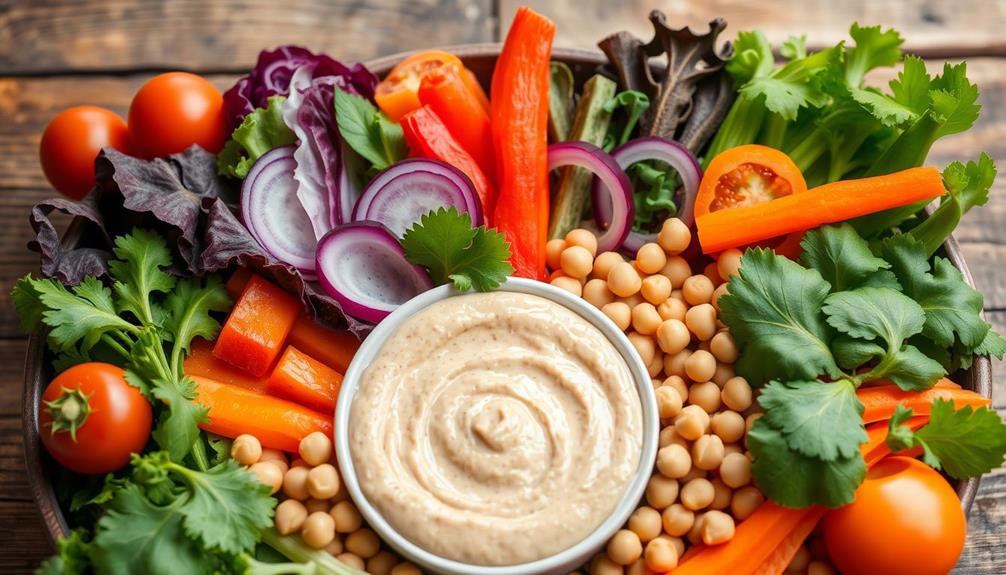
Raw foodism has gained popularity as more people discover the benefits of consuming unprocessed, nutrient-rich foods. This lifestyle emphasizes eating foods that haven't been heated above 104-118°F (40-48°C), preserving essential nutrients and live enzymes. You'll primarily focus on fruits, vegetables, nuts, seeds, and sprouted grains, which enhance nutrient absorption and digestion.
Here's a quick comparison of raw food staples:
| Raw Food Item | Benefits |
|---|---|
| Fruits | High in vitamins and antioxidants |
| Vegetables | Rich in fiber and hydration |
| Nuts | Source of healthy fats |
| Sprouted Beans | Easier to digest, nutrient-dense |
| Tahini | Creamy texture, rich in calcium |
Advocates of raw foodism claim it leads to improved energy levels, weight loss, and lower risks of chronic diseases due to high fiber intake. While it encourages creativity in meal prep—through methods like blending and dehydrating—you must balance your diet to avoid nutrient deficiencies. Embracing raw food can be a tasty and invigorating journey, especially when incorporating ingredients like tahini and sprouted beans into your dishes.
Hummus and Vegan Status
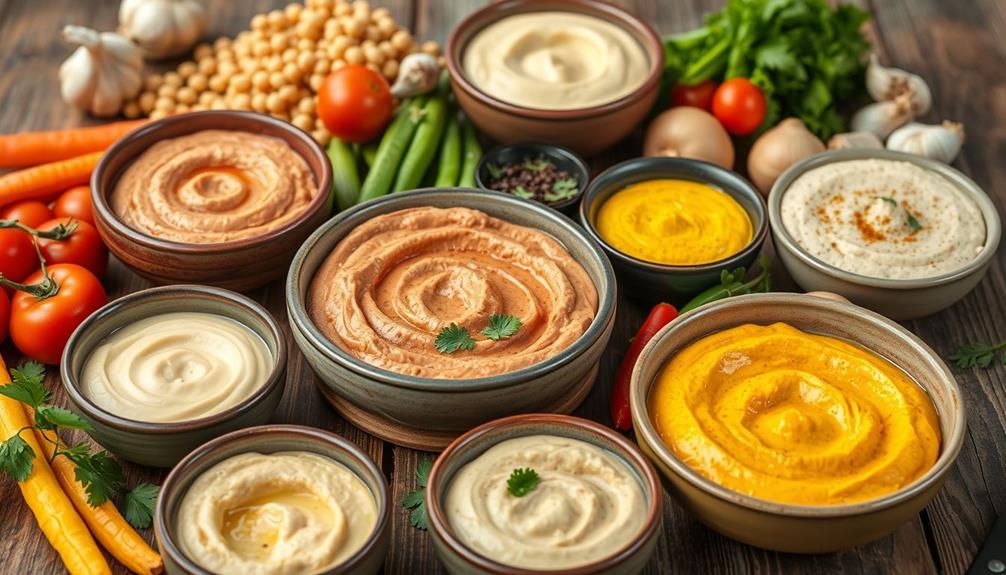
Hummus is typically vegan since it's made from all plant-based ingredients like garbanzo beans and tahini.
It's important to take into account that the nutritional benefits of hummus can contribute positively to a balanced diet, promoting key domains of development for both children and adults.
However, you need to be careful when choosing flavored varieties, as some may contain non-vegan additives.
Always check labels to verify your hummus aligns with your vegan lifestyle.
Hummus Vegan Ingredients
Most hummus varieties are vegan, as they consist mainly of plant-based ingredients like garbanzo beans, tahini, olive oil, lemon juice, and garlic. This means you can enjoy hummus without worrying about animal products.
When you whip up a hummus recipe, you're likely using these core ingredients, all of which are vegan-friendly. Additionally, you can enhance your hummus experience by exploring the importance of selecting the right cold medication that can complement your healthy eating habits.
However, keep in mind that some flavored hummus options may include non-vegan additives. So, if you're following a strict vegan lifestyle, it's crucial to check the ingredient list carefully. Brands like HOPE guarantee their vegan status by ensuring no animal-derived products are used in their facilities, which can give you peace of mind.
If you're interested in raw vegan options, traditional hummus isn't raw due to cooked garbanzo beans. But you can find raw hummus recipes that utilize sprouted garbanzo beans, allowing you to stay within the raw food classification.
Non-Vegan Additives Awareness
When choosing hummus, you need to be aware that not all varieties are strictly vegan. While traditional hummus is generally vegan, some brands include non-vegan additives that can sneak into the ingredients list. For instance, certain flavorings or preservatives might contain animal-derived components, which disqualifies them from being vegan-friendly.
Additionally, understanding financial terms like credit score can help you make informed choices when budgeting for your food expenses.
Commercially produced hummus can sometimes include dairy-based ingredients or honey, which aren't acceptable for a strict vegan diet. The Vegan Society defines a vegan product as one that contains no animal products or by-products, making it essential for you to scrutinize the ingredients in your hummus.
If you're following a raw diet, be especially cautious. Even flavored hummus options, which may seem appealing, often introduce non-vegan elements that you wouldn't expect.
Some brands, like HOPE, prioritize vegan standards by ensuring their recipes and production facilities are free from animal-derived products. Always check the labels to confirm that the hummus you're enjoying aligns with your dietary choices.
Hummus Ingredients Breakdown
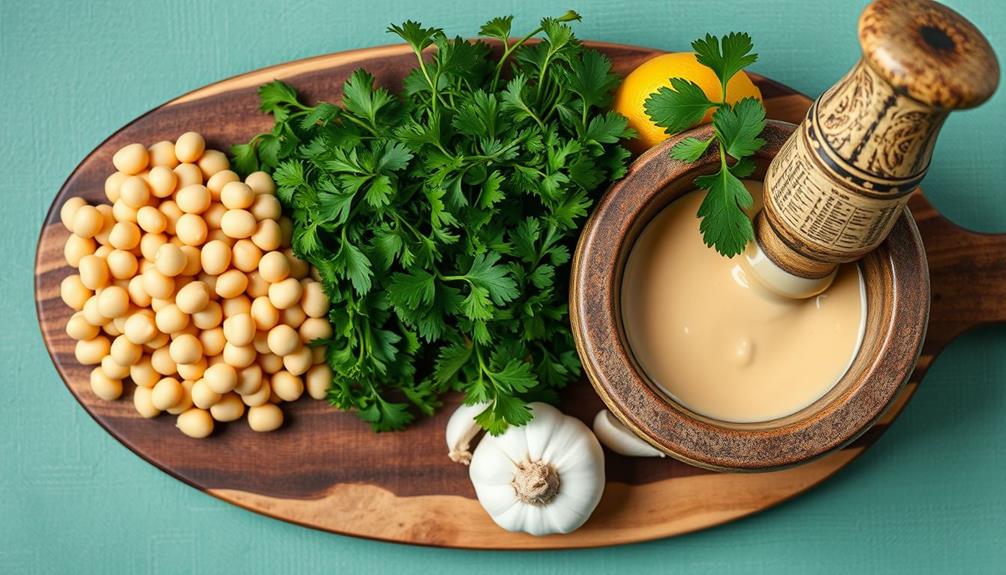
When you look at hummus, it's important to understand its key ingredients and their nutritional benefits.
Traditional hummus features cooked garbanzo beans, tahini, olive oil, lemon juice, and garlic, each contributing unique flavors and nutrients.
Additionally, incorporating certain essential oils for respiratory health can enhance your overall wellness while enjoying hummus.
Key Ingredients Overview
While traditional hummus often features cooked garbanzo beans, its key ingredients can be adapted for a raw food approach. To create a raw version, you can use sprouted chickpeas as the base instead of the usual cooked ones. Sprouting not only gives the chickpeas a creamy texture but also maintains the nutritional benefits associated with raw foods.
It's crucial to verify that any equipment used for preparation is properly sanitized to avoid contamination, similar to the importance of hygiene in piercing care and hygiene.
Tahini, another vital ingredient, is made from ground sesame seeds and can be raw if prepared without heat. This guarantees that your hummus remains in line with raw food principles. You'll also want to include fresh lemon juice and garlic, which enhance the flavor while providing additional health benefits when consumed raw.
Olive oil can be included too, but make certain it's cold-pressed to maintain its raw status. By creatively substituting these ingredients, you can whip up a delicious, nutritious hummus that aligns with raw food diets.
This way, you can enjoy a classic dish while adhering to your dietary preferences. Keep in mind that the key to raw hummus lies in your choice of ingredients and preparation methods.
Nutritional Benefits Explained
Exploring the nutritional benefits of hummus reveals a powerhouse of health-promoting ingredients. While traditional hummus isn't classified as raw food due to the use of cooked garbanzo beans, it still offers numerous advantages for your diet. Each serving provides approximately 7-8 grams of plant-based protein, making it a great addition to your meals for meeting daily nutritional needs.
Additionally, the use of fresh ingredients like garlic can provide anti-inflammatory properties that enhance overall health. The inclusion of tahini adds healthy monounsaturated fats, which are beneficial for heart health and can help lower cholesterol levels.
Fresh lemon juice not only brightens the flavor but also contributes vitamin C, which enhances your immune system and provides antioxidant benefits. Don't overlook garlic, either; it's known for its anti-inflammatory properties and may boost your body's ability to fight infections.
Incorporating hummus into your diet can support overall health, even if it's not a raw food. It's versatile, easy to make, and can be paired with fresh veggies or whole-grain crackers.
Is Hummus Raw?
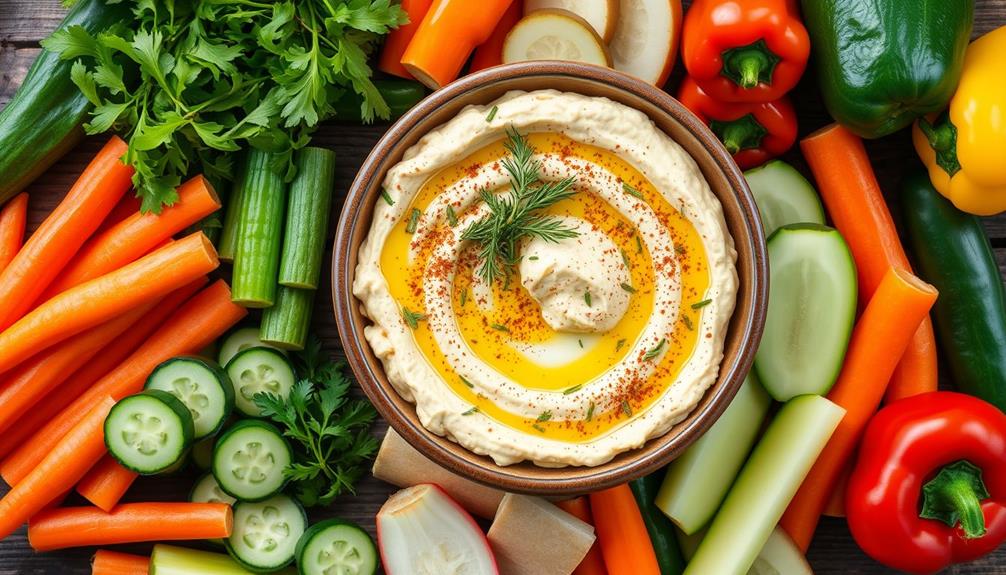
Many people wonder if hummus can be considered raw food, and the answer is generally no. Traditional hummus typically contains cooked garbanzo beans, which are heated above the raw food threshold of 115°F. This cooking process disqualifies it from being labeled as raw food.
Additionally, many commercial hummus brands undergo heat pasteurization, further confirming their cooked status. Glycolic acid aids in exfoliation and promotes healthy ingredients, which is an interesting consideration for those exploring food textures and benefits.
For hummus to be classified as raw, it must be made using sprouted beans or other ingredients that haven't been cooked or heated. While brands like HOPE use High Pressure Processing (HPP) to maintain freshness without heat, they still use cooked garbanzo beans, so they don't qualify as raw either.
If you're interested in a raw version of hummus, consider making it with sprouted beans, zucchini, or other raw ingredients. These alternatives can help you achieve a similar texture and flavor profile while keeping your dish within the raw food guidelines.
Raw Hummus Preparation
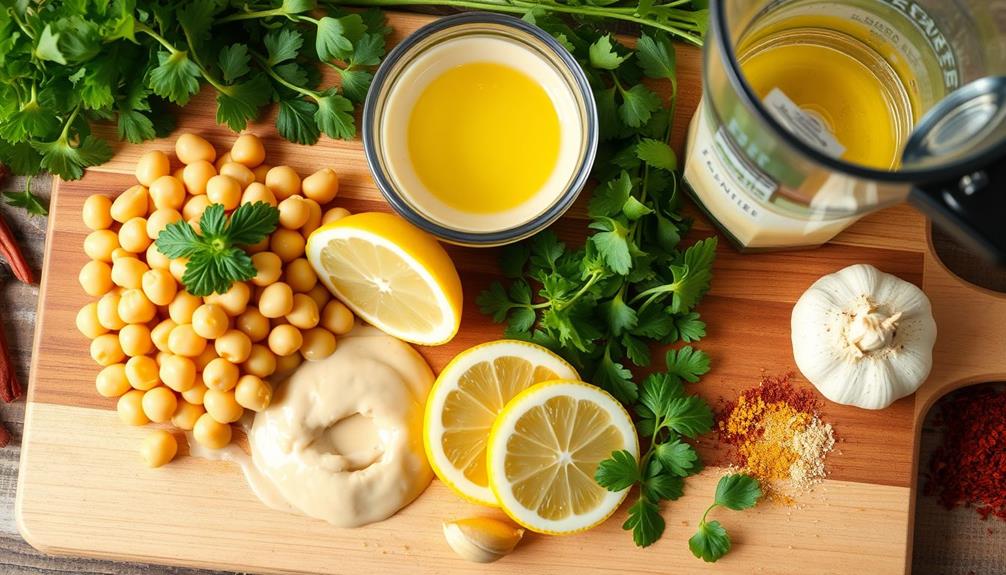
To create a delicious raw hummus, start by using sprouted beans instead of the traditional cooked chickpeas. This method not only enhances the flavor but also increases the nutritional value, making it a healthier option for your diet.
Begin by soaking your beans for 24 hours, then rinse them and let them sprout for 2-3 days, ensuring to rinse them regularly for freshness. Once they're ready, gather your key ingredients: tahini, fresh lemon juice, garlic, sea salt, and a splash of extra virgin olive oil for richness.
You might also consider adding a touch of caffeine content in espresso shots to your routine for an energy boost while preparing your meal.
In a food processor, combine the sprouted beans, tahini, lemon juice, garlic, sea salt, and olive oil. Blend the mixture for 3 to 5 minutes until you achieve a smooth, creamy texture. You can adjust the consistency by adding a bit of water or more olive oil if needed.
Taste and tweak the seasoning to your liking, perhaps adding a pinch of cumin or paprika for extra flavor.
Raw hummus pairs wonderfully with fresh vegetables like carrots, cucumbers, or bell peppers. You can also serve it alongside homemade raw flax crackers for a nutritious snack that's sure to impress.
Enjoy your healthy, flavorful creation!
Nutritional Benefits of Raw Hummus
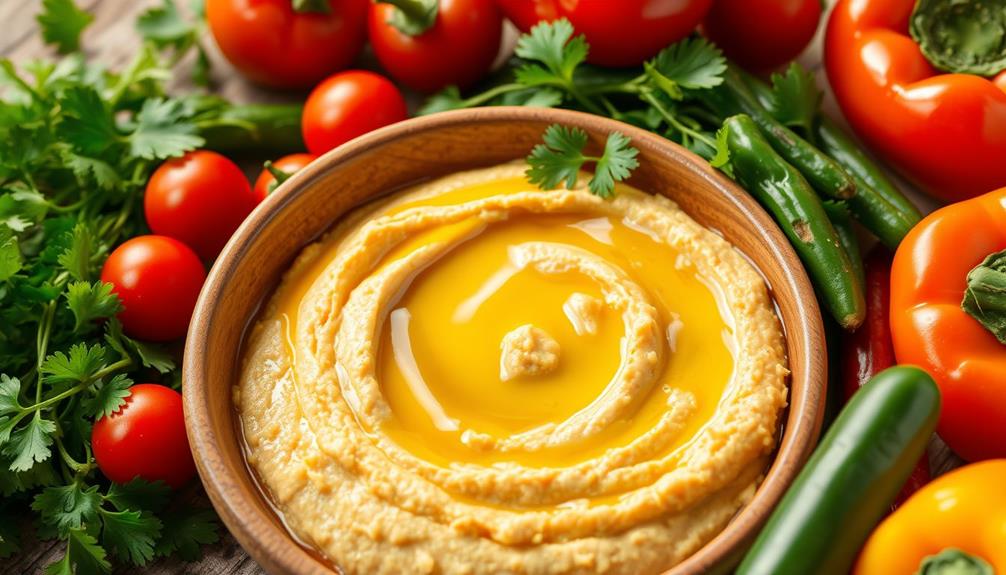
Harnessing the power of raw ingredients, raw hummus offers an impressive array of nutritional benefits that can enhance your overall health. Made from sprouted beans, it increases nutrient availability and improves digestibility compared to traditional cooked options.
The sprouting process not only boosts essential vitamins and minerals but also retains live enzymes that aid digestion and nutrient absorption, supporting your gut health. Incorporating healthy fats from top yoga trapeze options can further promote overall wellness.
When you incorporate raw tahini, fresh lemon juice, and garlic into your hummus, you add healthy fats, vitamins, and minerals that are beneficial for immune function.
The fiber content in raw hummus contributes to improved digestive health, helping you feel full longer and making it a satisfying snack choice.
Quality of Ingredients
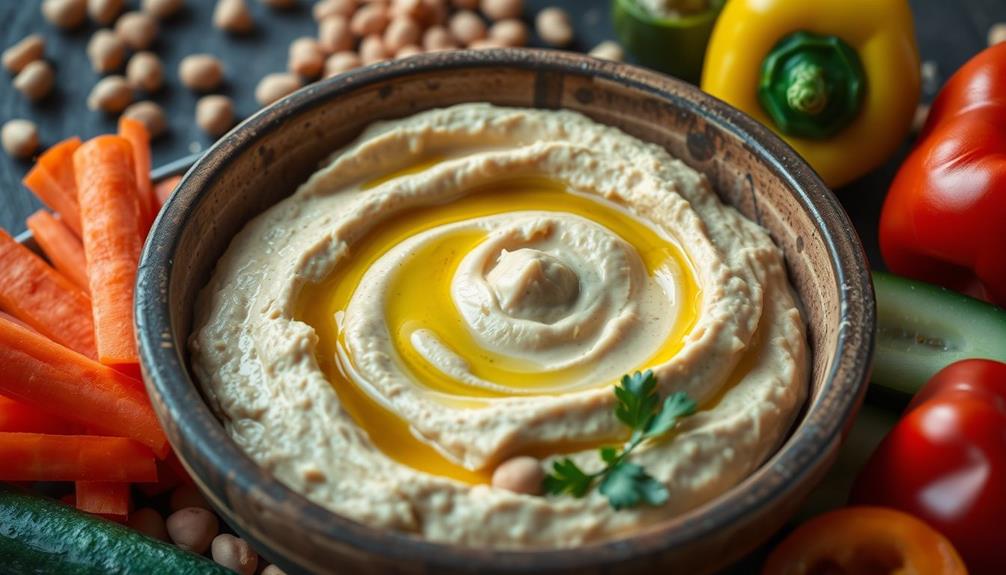
The quality of ingredients you choose for your hummus can notably impact its flavor and health benefits. Fresh, high-quality components not only enhance taste but also boost nutritional value.
When preparing raw hummus, opt for organic ingredients like USDA Certified Organic tahini and cold-pressed olive oil to reduce exposure to harmful pesticides and chemicals. This aligns perfectly with raw food principles.
Don't overlook the importance of freshly squeezed lemon juice; it improves the flavor and maintains the necessary acidity balance for raw food preparation. Avoid processed ingredients altogether, as they can detract from the health benefits of your hummus.
One key ingredient to take into account is garbanzo beans. Choosing sprouted or raw varieties can greatly increase the nutrient content compared to conventional canned beans.
Sprouted beans are easier to digest and offer enhanced flavor, making them a superior choice for your hummus.
Recipe for Raw Hummus
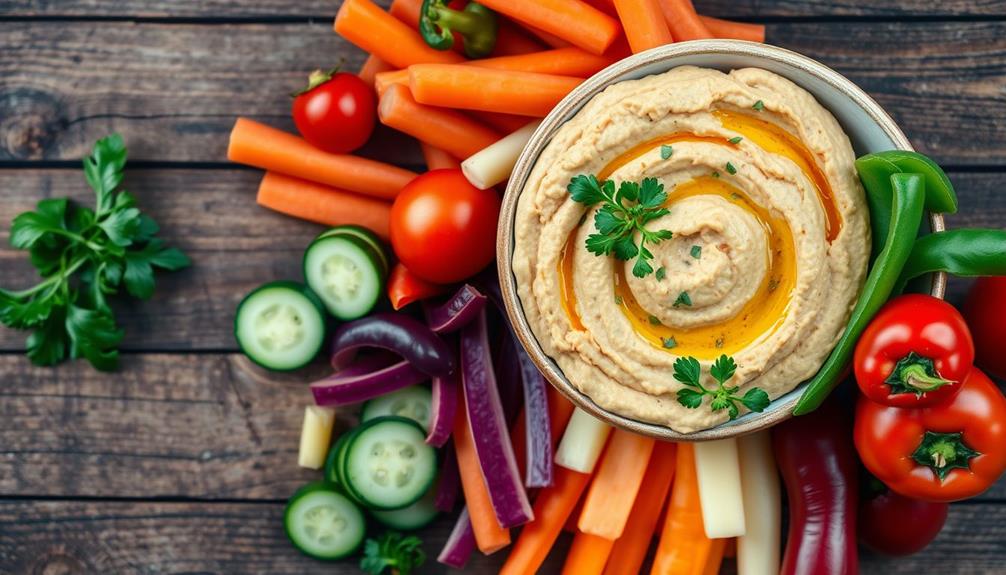
Creating a delicious raw hummus is easier than you might think, and it offers a nutritious twist on the classic recipe. To make this vibrant and creamy dip, start with zucchini as your base instead of traditional chickpeas. Zucchini provides a smooth texture while keeping the dish raw and fresh.
You'll need sprouted beans for added nutrition, along with raw vegan tahini, fresh lemon juice, garlic, cold-pressed olive oil, and sea salt. Combine all these ingredients in a high-speed blender. Blend for about 3 to 5 minutes until you achieve a silky consistency. If it's too thick, don't hesitate to adjust the texture by adding a little water or more lemon juice.
This raw hummus pairs wonderfully with fresh vegetables like carrots, cucumber, and bell peppers. You can also serve it with homemade raw flax crackers for a crunchy contrast.
Not only is this dip versatile and healthy, but it also embodies the raw food principles while satisfying your cravings. Enjoy the fresh flavors and nourishing ingredients in your next snack or appetizer!
Frequently Asked Questions
What Food Category Is Hummus?
Hummus fits into the plant-based dip or spread category. Typically, it's made from cooked chickpeas, tahini, and other ingredients, making it a versatile option for snacking or as a flavorful addition to meals.
Can You Eat Chickpeas on a Raw Food Diet?
You can absolutely eat chickpeas on a raw food diet! Just soak and sprout them, and you'll reveal a treasure trove of nutrients. These sprouted gems can spice up your meals in deliciously creative ways!
What Counts as Raw Food?
Raw food counts as unprocessed, uncooked items not heated above 118°F. You'll enjoy fresh fruits, veggies, nuts, seeds, and sprouted grains, often prepared through methods like juicing, blending, or dehydrating to maintain nutrients.
Is Hummus Made With Raw or Cooked Chickpeas?
Hummus is typically made with cooked chickpeas, which means it's not raw. If you want a raw version, look for recipes using sprouted chickpeas or other raw ingredients to enjoy a healthier option.
Conclusion
So, is hummus truly raw? As you savor each creamy bite, consider the journey of its ingredients—from sun-kissed chickpeas to vibrant garlic and zesty lemon. Imagine the vibrant colors and fresh flavors dancing on your palate, awakening your senses. If you choose to whip up raw hummus, you're not just enjoying a dip; you're embracing a lifestyle. The next time you dip that crisp veggie, remember: it's not just food; it's a delicious adventure waiting to unfold.

